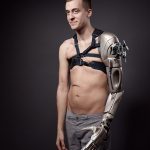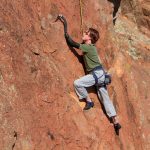Charlotte’s story
Charlotte was born without one of her hands, and chooses not to wear a prosthetic. This doesn’t stop her from doing things that we might imagine would be difficult, like tying her laces and riding a bike.

Image © Alternative Limb Project
Some prosthetics are custom built, like James Young’s which is designed to look and act like a character from the computer game Metal Gear Solid™).
Some prosthetics can be 3-D printed, and some have even been made from Lego™)!
Should people who have missing limbs use prosthetics to fit in with what is seen as ‘normal’, or can society cope with people who appear different? What do you think?
Liz’s story
Liz is a recent amputee, and has been fitted with a high-tech prosthetic called a Bebionic™ so that she can continue to work as a nurse. She also has a cosmetic prosthetic arm, which has been custom painted for her by a tattoo artist. Her prosthetics are as individual and unique as she is, not just a tool – they are part of her and her style.
Prosthetics and sport
Prosthetics can be adapted for use in sport – whether by elite Paralympians, or those who just want to have fun and keep fit.

Image © Advanced Arm Dynamics
Prosthetics in sport create different challenges not only for their designers but also for the people who make the rules that govern sports.
As technology and designs improve, prosthetics can add advantage to their user. They can be made lighter, stronger more flexible, made of smart materials such as carbon fibre and bespoke to the exact dimensions needed by their user for a certain sport.
A prosthetic can be optimised to an athlete’s height, weight and force production. Getting the limb just right is a complex and bespoke process of engineering related to science and art.
Jon-Allan’s story
Jon-Allan won a gold medal in the team cycling event at the Rio Olympics. For cycling, he uses a specialised lightweight prosthetic, looking more like part of a bike than an arm. His everyday prosthetic is a body powered split hook, the design of which hasn’t changed much since World War I. He has found that this design enables him to do what he needs to, like cutting up steak, and had the added bonus that it is reliable.